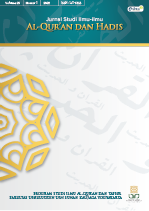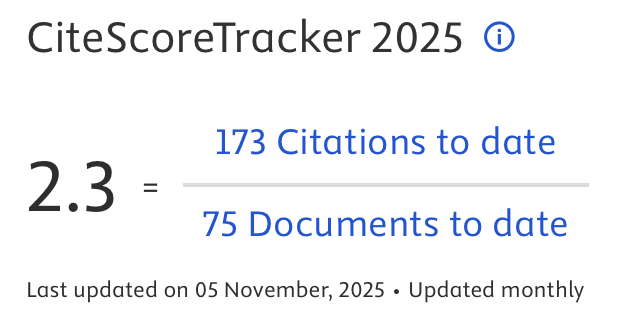Min al-Ḥarbi ḷla al-ḷṣlaḥ wa al-Salam: Tafsiru Āyāti āl-Ǧihād ʿala Ḍawʾi Maqaṣidihā
DOI:
https://doi.org/10.14421/qh.2022.2301-08Keywords:
Maqasid, Jihad Verses, Reformation, Peace, WarAbstract
The interpretation of jihadi verses has been still within the framework of the vision of "preserving one of the six primary needs" and has not yet come to the vision of the preservation of the six needs. In fact, jihad is the peak of militancy in Islam that must pay attention to all needs and needs in Islam. This research aims to conduct an in-depth study of the purpose of jihad depicted in the verses of the Qur'an and how it is applied and achieved in the present era. This study used the maqasidi maudu'i method to determine the verses of jihad as well as the maqasidi aspects in the verse. Aspects of maqasidi are traced using the language analysis commonly used in ushul fiqh. The maqasid findings were then developed with a new concept of the six primary human needs (al-daruriyat al-sitt) and implemented in today's needs in accordance with the concept (ihya' al-Qur'an). Referring to the ideal concept of maqasid jihad in the Qur'an, the practice of jihad can be stated that it is still not comprehensive because it is only one way to achieve the six primary needs of man while ignoring the rest and even eliminating it to the point of damaging it. At the same time, the study also highlights the importance of developing the vision-mission (maqasid) that jihadi verses aim for: from the generally "to defend and attack" to the mission of "reform and peace." The research also recommends reviving this vision of reform and peace in reviving the maqasid of jihadi verses in various countries.
 Abstract viewed: 539 times
|
Abstract viewed: 539 times
|
 PDF downloaded = 422 times
PDF downloaded = 422 times
References
‘Audah, J. (2011). Maqasid al-Shari‘ah: Dalil li al-Mubtadi’in. al-Ma‘had al-‘Alami li al-Fikr al-Islami.
Al-‘Asqalani, A. bin ‘Ali bin H. (1960). Fath al-Bari Sharh Sahih al-Bukhari (M. F. A. Al-Baqi (Ed.)). Dar al-Ma’rifah.
Al-Azhari, U. al-S. (2015). Al-Fahm al-Munir li al-Ayat al-Lati Akhta’a Fahmaha Ahl ul-Tatarruf wa al-Takfir. Dar al-Faqih.
Al-Bahuti, M. bin I. (1993). Sharh Muntaha al-Iradat. Alam al-Kutub.
Al-Buti, M. S. R. (1993). al-Jihad fi al-Islam: Kayfa Nafhamuh wa Kayfa Numarisuh. Dar al-Fikr & Dar al-Fikr al-Mu‘asir.
Al-Kashnawi, A. B. bin al-H. (2000). Ashal al-Madarik. Dar al-Fikr.
Al-Naysaburi, M. bin al-H. (2005). Sahih Muslim. Dar al-Fikr.
Al-Raysuni, A. (2010). Madkhal Ila Maqasid al-Shari‘ah. Dar al-Kalimah.
Al-Shatibi, I. al-G. (n.d.). al-Muwafaqat fi Usul al-Shari‘ah (A. Darraz (Ed.)). Dar al-Ma’rifah.
Al-Sharqawi, A. bin H. (n.d.). Hashiyah al-Sharqawi. Dar Ihya al-Kutub.
Al-Zabidi, M. bin M. bin A. al-R. al-H. (2010). Taj al-`Arus Min Jawahir al-Qamus. Dar al-Hidayah.
Anshori, M. A. (2019). The Radical Islamic Movement in Indonesia: Roots and Factors. Kalam, 13(2), 217–236. https://doi.org/https://doi.org/10.24042/klm.v13i2.5251
Bajoria, J. (2020). Corona Jihad is Only the Latest Manifestation: Islamophobia in India has Been Years in the Making | Human Rights Watch. The Polis Project. https://www.hrw.org/news/2020/05/01/coronajihad-only-latest-manifestation-islamophobia-india-has-been-years-making
Bazian, H. (2014). Editorial Statement. Islamophobia Studies Journal, 2(1), 1–7. https://www.crg.berkeley.edu/crg-publications/islamophobia-studies-journal-spring-2014-volume-2-issue-1/
Farhat, N. I., & Al-‘Uff, B. (2017). al-Jihad Bayn al-Maqasid wa al-Wasa’il. Al-Aqsa University Journal (Humanities Series), 2(21), 109–141. https://www.alaqsa.edu.ps/site_resources/aqsa_magazine/files/1160.pdf
Hasbillah, A. ’Ubaydi. (2020). al-Fawa’id al-Mustafawiyah al-Mustamaddah Min Ahadith al-Arba`in al-Nawawiyah fi Bina’ Kawadir al-A’immah wa “Ulama” al-Ummah. Maktabah Darus-Sunnah.
HRC-UN. (2021a). Khabir Umami: al-Karahiyah Dlidd al-Muslimin Tartafi` Ila al-Ab’ad al-Waba’iyyah. Akhbar Al-Umam Al-Muttah}idah. https://news.un.org/ar/story/2021/03/1071952
HRC-UN. (2021b). UN leaders speak out against Islamophobia and anti-Muslim hatred. UN News. https://news.un.org/en/story/2021/03/1087572
Ibn ‘Ashur, M. al-T. (2006). Maqasid al-Shari‘ah al-Islamiyah. Dar Suhnun.
Ibn `Asakir, A. al-Q. A. bin al-H. (1995). Tarikh Dimasyq (`Amr bin Gharamah Al-`Amrawi (Ed.)). Dar al-Fikr.
Ibn Abidin, M. A. bin U. bin A. al-A. al-D. (1992). Radd al-Mukhtar ‘Ala al-Durr al-Mukhtar (2nd ed.). Dar al-Fikr.
Ibn Manzur, M. bin M. bin A. (1993). Lisan al-`Arab. Dar Sadir.
Kaye, D. (2021). Advance Edited Version. In Human Rights Council: Vol. 46/30 (Issue April 13, 2021). https://www.ohchr.org/EN/HRBodies/HRC/RegularSessions/Session46/Documents/A_HRC_46_30.docx
Kosasih, A., & Firmansyah, M. I. (2018). UPI Students’ Perceptions of Jihad Based on Their Regions of Origin. 1st UPI International Geography Seminar 2017, IOP Conf. Series: Earth and Environmental Science.
Muzakki, A. (2018). Memahami Ayat-ayat Jihad dalam Al-Qur`an: Sebuah Kajian Makna dalam Perspektif Semiotika Sosial. Lembaga Penelitian dan Pengabdian Kepada Masyarakat (LP2M). http://repository.uin-malang.ac.id/7852/1/LP2M 2018.pdf
Rijal, S. (2016). Islam dan Jihad: Pencarian Kedamaian dan Toleransi. JISCA: Journal of Islamic Civilization in Southeast Asia, 5(2). http://journal.uin-alauddin.ac.id/index.php/jicsa/article/view/2352
Shaltut, M. (n.d.). al-Qur’an wa al-Qital. Matba‘ah Dar al-Kitab al-‘Arabi.
Shukri, S. F. M. (2019). The Perception of Indonesian Youths toward Islamophobia: An Exploratory Study. Islamophobia Studies Journal, 5(1), 61–75. https://www.jstor.org/stable/10.13169/islastudj.5.1.0061
Umar, N. (2006). al-Quran di Mata Mantan Intelektual Muslim: Ibn Warraq dan Mar A. Gabriel. Jurnal Studi Al-Quran, 1(2).
Umar, N. (2014). Deradikalisasi Pemahaman al-Quran dan Hadis. PT Elex Media Komputindo.
Yaqub, A. M. (2010). al-Islam Bayn al-Harb wa al-Salam. Pustaka Firdaus.
Zherlitsyna, N. A. (2021). Prospects for global jihadism in Southeast Asia. Asia and Africa Today, 10. https://doi.org/10.31857/s032150750017090-1
Downloads
Published
How to Cite
Issue
Section
License
Publishing your paper with Jurnal Studi Ilmu-ilmu al-Qur'an dan Hadis means that the author or authors retain the copyright in the paper. Jurnal Studi Ilmu-ilmu al-Qur'an dan Hadis uses license CC-BY-NC-ND or an equivalent license as the optimal license for the publication, distribution, use, and reuse of scholarly works. This license permits anyone to copy and redistribute the material in any medium or format and must give appropriate credit, provide a link to the license, and indicate if changes were made. If you remix, translate, transform or build upon the material you may use it for private use only and not for distribution. Jurnal Studi Ilmu-ilmu al-Qur'an dan Hadis granted an exclusive non-commercial reuse license by the author(s), but the author(s) are able to put the paper onto a website, distribute it to colleagues, give it to students, use it in your thesis, etc, so long as the use is not directed at a commercial advantage or toward private monetary gain. The author(s) can reuse the figures and tables and other information contained in their paper published by Jurnal Studi Ilmu-ilmu al-Qur'an dan Hadis in future papers or work without having to ask anyone for permission, provided that the figures, tables, or other information that is included in the new paper or work properly references the published paper as the source of the figures, tables or other information, and the new paper or work is not direct at a private monetary gain or commercial advantage.
Jurnal Studi Ilmu-ilmu al-Qur'an dan Hadis journal Open Acces articles are distrubuted under the Creative Commons Attribution-NonCommercial-NoDerivatives 4.0 International (CC BY-NC-ND 4.0). Article can be read, copy and redistribute the material ini any medium or format under the following conditions:
Attribution — You must give appropriate credit, provide a link to the license, and indicate if changes were made. You may do so in any reasonable manner, but not in any way that suggests the licensor endorses you or your use.
NonCommercial — You may not use the material for commercial purposes.
NoDerivatives — If you remix, transform, or build upon the material, you may not distribute the modified material.










